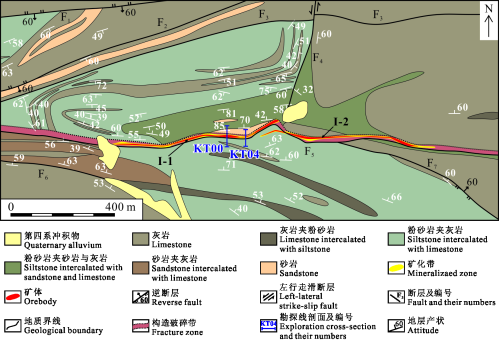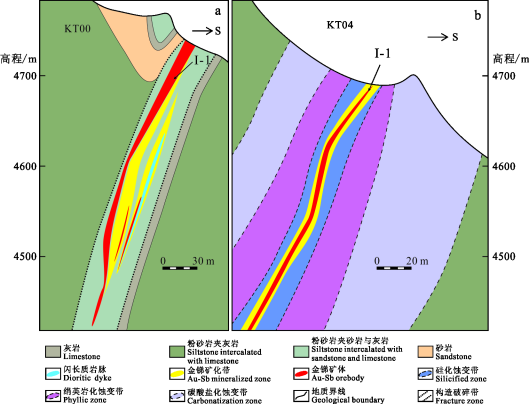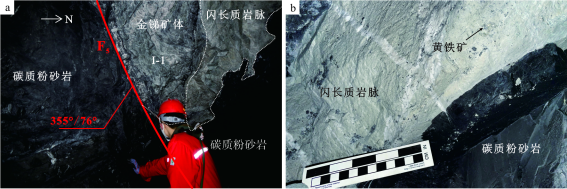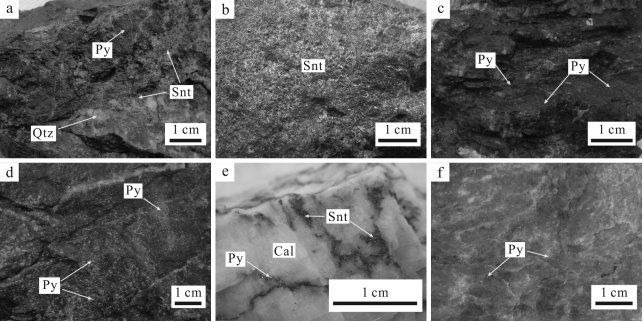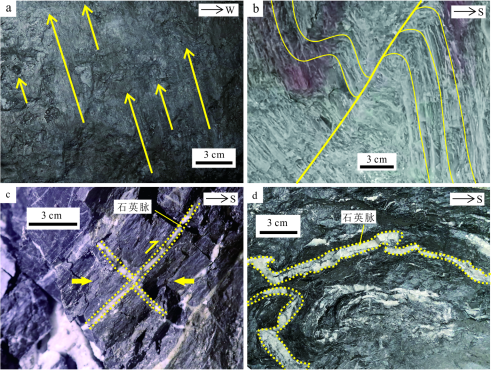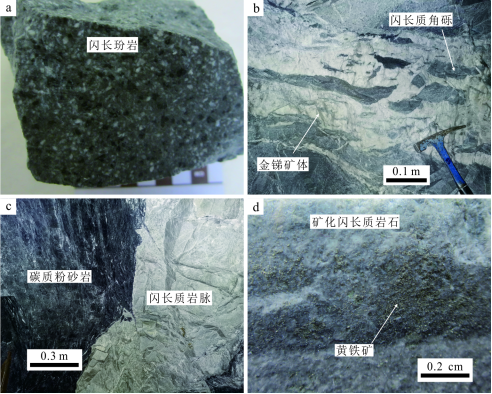-
东昆仑造山带作为中国中央造山系的重要组成部分,以显生宙多岛洋、软碰撞、多旋回复合造山作用为典型特征(莫宣学等,2007;杨经绥等,2005)。在长期的地质历史演化期间,该造山带发生了早古生代与晚古生代—早中生代两个时期的大规模金成矿事件,在其东段形成了以五龙沟、大场、沟里等为代表的众多大型—超大型金矿床(图1;张德全等,2001;2005;Chen et al., 2020;赵伟策等,2023)。然而,在东昆仑造山带的西段,至今尚未探明有与其东段相对等的金矿资源。近年来,在东昆仑造山带西段陆续发现有屈库勒克金矿床、屈库勒克东金锑矿床以及黄羊岭、卧龙岗等多个中型至大型锑矿床(郭利等,2020a;陈威等,2021;Xing et al., 2022),表明东昆仑造山带西段以大规模金-锑成矿作用为典型特征,不同于其东段的造山型金成矿作用。
新疆且末县屈库勒克东金锑矿床是近年来在东昆仑西段新发现的大型金锑矿床,拥有金资源量约21.0 t、锑资源量约7.3万t(Xing et al., 2022)。该矿床作为东昆仑西段金锑矿床的典型代表,是研究区域金-锑成矿作用关键地质问题的良好对象,但目前的研究程度较低,其成因机制及矿床类型尚存争议。前人基于矿床地质特征研究,开展了初步的成矿年代学、含矿闪长质岩脉年代学与岩石地球化学、含金黄铁矿矿物化学等方面的工作,并提出该矿床与晚三叠世岩浆侵入活动存在密切联系,属中低温热液型金矿床(郭利等,2019a;2019b)或与侵入体相关的金矿床(Xing et al., 2022;2023a;2023b)。然而,野外地质调查表明,金锑矿化及相关蚀变严格受控于近东西向断层破碎带,主要赋存于上石炭统哈拉米兰河群浅变质细碎屑岩中,矿化以脉状、浸染状为主,主要与硅化、绢云母化蚀变有关(郭利等,2019a),这些矿化特征与中低温热液型金矿床或侵入体相关金矿床的矿化特征存在一定差异,反而显示出与典型的断层控矿造山型金矿床的高度相似性。因此,屈库勒克东金锑矿床的矿床类型及其成因机制亟待阐明,控矿断裂构造的几何学与运动学属性及其控矿机制也缺乏精细的解析,这些关键地质问题直接制约着进一步深部找矿与勘查工程的部署。
笔者团队在屈库勒克东金锑矿床开展了详细的野外地质调查与构造观测,阐明了其成矿地质特征与控矿断裂构造几何样式、运动学属性,并结合前人研究成果,探讨了其成因机制,以期为屈库勒克东地区以及东昆仑西段的金锑矿勘查与找矿工作提供理论支撑。
1区域地质背景东昆仑造山带位于青藏高原北缘,近东西向绵延约1500 km,其南北两侧分别被巴颜喀拉地体、柴达木地块所夹持,向东与秦岭—大别造山带相接,西侧与西昆仑造山带相连,但被阿尔金左行走滑断裂系所截错(图1a)。东昆仑造山带发育红柳泉—格尔木断裂、昆北断裂、昆中断裂、昆南断裂等多条具有缝合带性质的近东西向区域性深大断裂带,其中,昆北断裂与昆中断裂将东昆仑造山带自北向南依次划分为昆北带、昆中带、昆南带等3个构造单元(图1b;Dong et al., 2018;董云鹏等,2022)。昆北带又称北祁漫塔格带,由古元古界变质基底和古生界—中生界盖层组成,后者包括奥陶系—志留系弧后火山-沉积建造、泥盆系磨拉石建造、石炭系—下二叠统陆相沉积岩系、中三叠统—上三叠统火山-沉积序列以及侏罗系碎屑岩,不整合覆盖在古老变质基底之上(姜春发等,1992)。昆中带由古元古界高级变质杂岩与中元古界低级变质岩构成前寒武纪变质基底,上覆由下泥盆统—中泥盆统碎屑岩与碳酸盐岩建造、上泥盆统磨拉石沉积、石炭系—下二叠统与中三叠统—上三叠统火山-沉积岩系所组成的显生宙盖层(潘裕声等,1996)。昆中带广泛发育新元古代至早中生代侵入岩并构成昆中带的主体,其在早古生代具有岛弧带特征,晚古生代—三叠纪演化为陆缘弧环境(莫宣学等,2007;He et al., 2016)。昆南带为卷入区域强逆冲推覆/剪切变形的增生杂岩构造带,少量出露经历角闪岩相变质作用的前寒武纪变质基底,上覆由古生界—三叠系火山-沉积岩系构成的、断续出露的推覆体,并发育早古生代与二叠纪—三叠纪中酸性侵入岩,分别对应于原特提斯洋与古特提斯洋的俯冲、消减及伴随的碰撞造山演化过程(刘成东等,2004;刘战庆等,2011;Dong et al., 2018;董云鹏等,2022)。
2矿床地质特征2.1地质概况屈库勒克东金锑矿床出露的地层较为简单,包括上石炭统哈拉米兰河群以及上覆的第四系冲积物。哈拉米兰河群为一套浅海相碎屑岩夹碳酸盐岩建造,经历低级变质作用,岩性包括浅变质碳质粉砂岩、灰岩与中细粒砂岩等(图2)。矿区紧邻阿尔金左行走滑断裂带与昆南断裂,变形较强烈,发育近东西向(F1、F5、F6)、近北东向(F2、F3)、近南北向(F4)与近北西向(F7)等断裂(图2)。其中,近东西走向、陡倾向北的F5断裂(倾向340°~20°、倾角55°~85°)及其构造破碎带控制了矿区蚀变带、金锑矿化带及具有工业价值的金锑矿体的空间产出与分布(图3a~b、图4a)。此外,在矿区中部,F5断裂的上盘发育有一条近东西走向的紧闭向斜,沿走向延伸约1.7 km,轴面近直立(图3a)。矿区岩浆侵入活动主要表现为深部隐伏矿化带内断续出露的规模不等的闪长质岩脉,与地层接触界线截然明显(图4b)。闪长质岩脉多呈透镜状、脉状产出,产状受控于近东西向F5断裂,为近东西走向,陡倾向北,单个岩脉厚度在0.2~0.5 m不等,沿走向延伸5~30 m。
图1东昆仑造山带构造位置图(a,据Yin et al., 2000修改)和大地构造简图(b,据Dong et al., 2018修改)
Fig. 1 Tectonic location (a, modified after Yin et al., 2000) and simplified tectonic map (b, modified after Dong et al., 2018)of the East Kunlun Orogen
图2屈库勒克东金锑矿床地质简图(据郭利等,2019a修改)
Fig. 2 Simplified geological map of the Qukulekedong Au-Sb deposit (modified after Guo et al., 2019a)
2.2矿化特征屈库勒克东金锑矿床共圈定6条具有工业价值的金锑矿体,其中,Ⅰ-1号和Ⅰ-2矿体是矿区规模最大、品位最高的2个金锑矿体,贡献了约97%的金锑资源量,矿石中金、锑的平均品位分别为6.8 g/t、3.9%(Xing et al., 2022)。金锑矿体产于近东西向F5断裂及其所控制的构造破碎带中,赋矿围岩主要是上石炭统哈拉米兰河群浅变质碳质粉砂岩,在闪长质岩脉中也发现有少量金锑矿化(图4)。矿体总体形态较为简单,单个矿体呈脉状、透镜状、似层状,局部地段具有分支、复合现象。矿体平面上呈近东西走向,延伸较稳定,控制延伸长1.2 km(图2);剖面上近直立,多数陡倾向北,倾角55°~75°,局部发生倒转而陡倾向南,控制垂距565 m(图3)。
矿石构造主要为浸染状、脉状、细脉状、块状等(图5)。矿物组合较为复杂,矿石矿物以辉锑矿、黄铁矿为主,其次为毒砂、黄铜矿、磁黄铁矿、自然金等,及微量方铅矿、闪锌矿。金主要以含银自然金的形式存在,呈粒间金、裂隙金赋存于黄铁矿、辉锑矿中;辉锑矿为主要的含锑矿物(郭利等,2012)。脉石矿物以石英、方解石、绢云母等为主。热液蚀变自矿体中心向两侧依次表现为硅化、绢云母化、碳酸盐化,受F5断裂的控制而具有明显的线性分布特征,金锑矿化主要与硅化、绢云母化密切相关(图3b)。根据矿物共生与穿切关系,可将屈库勒克东金锑矿床划分为5个成矿阶段:石英脉阶段(Ⅰ)、黄铁矿-石英脉阶段(Ⅱ)、含金黄铁矿-毒砂-石英脉阶段(Ⅲ)、自然金-辉锑矿-石英脉阶段(Ⅳ)、方解石脉阶段(Ⅴ)等(Xing et al., 2022)。
3控矿构造几何样式与运动学属性
屈库勒克东金锑矿床严格受控于F5断裂及相关构造破碎带(图2)。本文通过详细的野外地质调查,根据地表地质填图尺度与坑道内露头尺度构造变形的观测,并结合前人研究成果,现将F5控矿断裂的几何样式与运动学属性总结阐述如下。
F5断裂总体上呈近东西走向,在矿区内沿走向延伸超过2 km,部分地段因局部应力场的变化而表现出弯曲、起伏的平面几何样式(图2)。F5主断裂带陡倾向北(20°~340°),倾角55°~85°,已有坑道发现其向深部延伸超过0.5 km(图3)。根据断层面上擦痕线理、阶步、剪切破裂以及滑抹晶体等运动学标志,判断F5断裂主要显示逆断层的运动学属性,表明其应是近南北向挤压应力作用的产物(图6a)。此外,靠近主断裂带的上、下盘地层中也发育有大量露头尺度的近东西向展布的次级褶皱变形及相关劈理构造,同样指示近南北向挤压应力作用(图6b)。在F5断裂及相关构造破碎带内,普遍发育沿压扭性、张扭性、张性等厘米级至分米级的破裂或节理,由热液石英、方解石充填,不同产状的石英或方解石脉之间的相互切错关系以及次级褶皱变形也指示F5断裂是形成于近南北向挤压作用下的逆断层(图6c~d)。
图3屈库勒克东金锑矿床KT00(a)和KT04(b)勘探线剖面图(据郭利,2020b;Xing et al., 2022修改)
Fig. 3 Exploration cross-sections of KT00 (a) and KT04 (b) in the Qukulekedong Au-Sb deposit (modified after Guo, 2020;Xing et al., 2022)
图4屈库勒克东金锑矿床Ⅰ-1号矿体野外照片
a. F5断裂控制Ⅰ-1号金锑矿体的产出及闪长质岩脉的侵位;b.发生金锑矿化的闪长质岩脉
Fig. 4 Field photos of No.Ⅰ-1 orebody in the Qukulekedong Au-Sb deposita. Control of F5fault on the occurrence of No.Ⅰ-1 Au-Sb orebody and emplacement of dioritic dyke; b. Au-Sb mineralized dioritic dyke
图5屈库勒克东金锑矿床典型矿石照片
a.团斑状辉锑矿与浸染状黄铁矿;b.块状辉锑矿;c.脉状、浸染状黄铁矿;d.浸染状黄铁矿;e.细脉状辉锑矿、黄铁矿;f.浸染状黄铁矿
Snt—辉锑矿;Py—黄铁矿;Cal—方解石;Qtz—石英
Fig. 5 Photos of representative ores from the Qukulekedong Au-Sb deposit
a. Porphyritic stibnite and disseminated pyrite; b. Massive stibnite; c. Veined and disseminated pyrite; d. Disseminated pyrite; e. Stibnite and pyrite veinlets; f. Disseminated pyriteSnt—Stibnite; Py—Pyrite; Cal—Calcite; Qtz—Quartz
4讨论4.1控矿构造的动力学背景及其对成矿的控制本次野外地质调查表明,屈库勒克东金锑矿床严格受控于F5断裂及相关构造破碎带。野外构造观测与几何学、运动学解析表明,F5断裂具有近东西走向、陡倾向北的几何样式,指示自北向南的逆冲作用,是近南北向挤压应力作用下形成的逆断层。野外构造观测并结合前人研究成果表明,F5断裂往东、西方向均延伸至矿区外,其沿走向上延伸超过8 km,隶属于屈库勒克深大断裂系(郭利等,2019a)。前人通过区域地质调查与构造解析,根据空间关系、几何学与运动学属性及其配套关系,提出屈库勒克深大断裂系是区域上昆南断裂上盘伴随发育的主要次级断裂系统之一(新疆维吾尔自治区地质矿产勘查开发局,2016)。昆南断裂作为昆南增生杂岩带与巴颜喀拉地体的边界断裂,记录了古生代—早中生代古特提斯洋北向俯冲演化与闭合历史,是三叠纪古特提斯洋关闭及伴随的昆南带与巴颜喀拉地体碰撞过程中所形成的一条古构造缝合带,并导致其南北两侧产生了区域大规模指向南的强逆冲推覆/剪切变形带(刘成东等,2004;刘战庆等,2011;Dong et al., 2018)。因此,尽管缺乏对F5断裂活动时代通过同位素年代学的直接约束,但是基于其构造几何学样式与运动学属性并结合区域构造背景,笔者认为,屈库勒克东金锑矿床F5断裂及相关构造破碎带主要形成于区域三叠纪古特提斯洋关闭及伴随的同/晚碰撞造山环境。
野外观测表明,屈库勒克东金锑矿化带与高品位矿体的几何样式、空间展布和产出均与F5断裂具有高度的一致性,矿体基本上都产于F5断裂所控制的构造破碎带内(图4a);同时,Xing等(2022)获得含金毒砂的Re-Os等时线年龄(209±12)Ma;将金锑矿化的时间约束在晚三叠世,这与F5断裂的活动时代基本一致。此外,热液蚀变也呈现明显的沿F5断裂及相关构造破碎带展布的线性特征,上石炭统哈拉米兰河群碎屑岩夹碳酸盐岩建造也卷入到强烈的近南北向挤压应力作用所导致的F5断裂及相关变形带中(图3)。对于闪长质岩脉,无论是单个岩脉还是它们所组成的岩脉群,大体上均呈近东西走向、陡倾向北,呈现出与F5断裂相似的几何学特征,更为重要的是,这些闪长质岩脉几乎全部产于F5断裂所控制的构造破碎带内(图4a)。显然,F5断裂及相关构造破碎带不仅控制着金锑矿化与蚀变,对矿区出露地层和深部断续出现的闪长质岩脉群的几何学特征、空间展布与产出也都具有相当重要的影响和控制。因此,上述地质证据结合区域构造演化表明,屈库勒克东金锑矿床具有典型的断裂构造控矿的特征,金锑矿化很可能发生在三叠纪古特提斯洋关闭及伴随的碰撞造山晚/后期环境中。
图6屈库勒克东金锑矿床F5控矿断裂变形特征
a. F5断层面上的擦痕、阶步、反阶步等构造标志,指示自北向南的逆冲作用,黄色箭头表示缺失盘的运动方向;b. F5断层下盘次级褶皱变形及切穿褶皱的次级破裂;c.两组热液石英脉,指示近南北向挤压应力作用;d.发生褶皱变形的石英脉
Fig. 6 Deformation characteristics of the ore-controlling F5fault in the Qukulekedong Au-Sb deposit
a. Slickensides, steps, and anti-steps on the fault plane of F5fault indicating top-to-the-South thrusting, and yellow arrow represent slip direction of the missing fault block; b. Secondary fold in the footwall of the F5fault, crosscut by secondary fracture; c. Hydrothermal quartz veins with two different orientations, indicating N-S compression; d. Folded hydrothermal quartz veins
4.2闪长质岩脉在成矿过程中的作用前人通过成岩成矿同位素定年和地球化学示踪成矿物质来源,认为矿化带内断续出露的小规模闪长质岩脉与金锑成矿密切相关(郭利等,2019a;2019b;Xing et al., 2022;2023a;2023b)。根据矿区Ⅰ-1号矿体中含金毒砂Re-Os等时线年龄为(209±12)Ma,前人提出屈库勒克东金锑矿化主要发生于晚三叠世(Xing et al., 2022)。同时,矿区南部花岗闪长岩、矿化带内闪长玢岩脉的锆石U-Pb年龄分别为(214.8±1.1)Ma、(211.0±3.7)Ma,根据岩浆侵位年龄与矿化年龄的一致性,学者们将金锑矿化与晚三叠世岩浆侵入活动联系起来(郭利等,2019b;Xing et al., 2022)。以产于闪长质岩脉中及其附近的硫化物为对象,前人获得含金黄铁矿的硫同位素值(δ34S)介于-2.03‰~+2.67‰,表明该类黄铁矿中的硫很可能来自于岩浆硫;其铅同位素比值206Pb/204Pb的平均值为18.42,与花岗闪长岩、闪长玢岩的206Pb/204Pb平均值(18.28、18.22)接近,暗示铅很可能来自于晚三叠世侵入岩;微量元素分析获得其w(Co)/w(Ni)比值的平均值为4.93,表明其应是岩浆或热液成因的黄铁矿(Xing et al., 2023a;2023b)。据此,学者们建立了金锑矿化与闪长质岩脉之间的时间、空间及成因联系,进而提出该矿床属与岩浆-热液演化相关的中低温热液型金矿床(郭利等,2019a;2019b)或与侵入体相关的金矿床(Xing et al., 2022;2023a;2023b)。
本次针对矿区不同中段、不同矿化部位闪长质岩脉的观测表明,这些闪长质岩脉基本上呈近东西走向,断续出露,整体上看,其空间展布在纵向上有往深部断续延伸的特征,表明这些闪长质岩脉自浅部至深部具有一定的连通性,可能构成一定规模的岩脉群。尽管部分闪长质岩脉紧邻矿体产出,但是也有很大一部分远离矿体产出的闪长质岩脉中并没有发生金锑矿化(图3b、图7a)。闪长质岩脉与矿体之间并不具有不可分割的空间联系,暗示闪长质岩脉可能并非金锑矿化所必需的条件。同时,野外地质调查还发现,部分矿体内卷入有贫矿的闪长质角砾,其与矿区大范围出现的闪长质岩脉具有基本一致的岩相学特征,表明闪长质岩脉的侵位在时间上很可能不晚于金锑矿化的发生(图7a、b)。这些闪长质角砾显示与矿体近乎一致的几何学特征,表明它们很可能是在成矿过程中因断层作用和热液流体活动的共同控制而被卷入进矿体中。此外,无论是含矿的闪长质岩脉还是贫矿的闪长质岩脉,它们与碳质粉砂岩地层之间呈现出截然的接触关系,接触界线及其两侧的岩性均没有明显的与岩浆侵位过程有关的高温热蚀变晕以及由接触界线向其两侧的分带现象,因而很大可能属于同构造侵位所导致的“冷接触”,与高温岩浆侵位过程并无关系(图7c)。对于含矿的闪长质岩脉,其矿化类型主要以浸染状为主,多见黄铁矿呈浸染状、团斑状产于闪长质岩脉的裂隙或空隙中,并不显示侵入体相关金矿床的席状硫化物脉矿化和钾化蚀变(图4b、图7d)。因此,基于上述野外地质证据,有理由判断,闪长质岩脉中的金锑矿化很可能是岩浆侵位晚/后期的成矿过程中,热液流体沿闪长质岩脉中的裂隙贯入所导致的。闪长质岩脉在其侵位过程中提供了热源,形成局部热异常并导致地热梯度的紊乱及伴随的地下水循环,进而促使热液流体不断地萃取围岩(地层和早期侵位形成的岩脉)中的成矿物质,促进金锑矿化的发生。因此,闪长质岩脉可能并非是直接导致金锑矿化的关键控矿因素,其侵位过程显著提高了热液流体对围岩的萃取能力和效率,在金锑富集与成矿过程中更多地扮演着“催化剂”的角色。
图7屈库勒克东金锑矿床闪长质岩脉典型现象野外照片
a.不含矿的闪长玢岩;b.卷入金锑矿体中的不含矿的闪长质岩脉角砾;c.闪长质岩脉与碳质粉砂岩地层呈截然接触关系;d.矿化闪长质岩脉中的浸染状黄铁矿
Fig. 7 Field photos of representative dioritic dykes in the Qukulekedong Au-Sb deposit
a. Barren dioritic porphyry; b. Breccias of barren dioritic dykes enclosed in Au-Sb orebody; c. A direct contact relationship between dioritic dykes and carbonaceous siltstone; d. Disseminated pyrite within mineralized dioritic dyke
4.3矿床类型及其成因模式屈库勒克东金锑矿床在大地构造位置上处于东昆仑造山带西段的昆南带近东西向次级逆冲变形带内(图1b)。前文已述,金锑矿化发生于区域三叠纪古特提斯洋关闭及伴随的碰撞造山环境下,即汇聚板块边缘的收缩构造环境;在区域构造事件的影响下,矿区发生了普遍的低级变质变形作用,形成了近东西向、陡倾向北的F5断裂及其所控制的脆-韧性构造破碎带,控制着矿区金锑矿化带、高品位矿体、热液蚀变、赋矿碳质碎屑岩地层以及闪长质岩脉的几何样式、空间展布与产出,成为矿床尺度上金锑矿化的二级控矿构造。显然,屈库勒克东金锑矿床在成矿大地构造背景、断裂构造及其控矿特征以及从区域尺度到矿床尺度的控矿构造体系等方面均与典型造山型金矿床极为相似(Groves et al., 1998;Goldfarb et al., 2001)。
此外,本次野外地质调查表明,金锑矿化主要赋存于上石炭统哈拉米兰河群浅变质的碳质粉砂岩中,矿体主要呈脉状、透镜状,金属矿物组合以黄铁矿、辉锑矿为主,其次为毒砂、黄铜矿、磁黄铁矿、自然金等,常见块状、脉状与浸染状矿石,矿化与硅化、绢云母化蚀变密切相关,这些矿化特征也都与造山型金矿床的成矿地质特征基本一致(Groves et al., 1998;Goldfarb et al., 2001)。前人针对碳质粉砂岩和构造破碎带内石英-黄铁矿脉中的含金黄铁矿也做了相应的同位素与微量元素地球化学工作(Xing et al., 2023a)。硫-铅同位素分析结果表明,这2种产状的含金黄铁矿的δ34S值分别介于-12.23‰~-10.83‰、-18.68‰~+18.67‰之间,后者的铅同位素比值206Pb/204Pb的平均值(19.50)与碳质粉砂岩(19.99)非常接近,如此宽泛的硫同位素值以及硫化物与碳质地层之间相近的铅同位素比值均暗示成矿流体中有变质流体的加入(Xing et al., 2023a)。微量元素分析结果表明,这两种产状的含金黄铁矿均具有较低的w(Co)/w(Ni)比值,平均值分别为0.62和0.05,暗示成矿物质中有来自浅变质碳质粉砂岩的组分(Xing et al., 2023a)。因此,浅变质碳质地层及其所提供的变质流体也是屈库勒克东金锑矿床的流体和成矿物质的重要来源,这也符合造山型金矿床的成矿流体和物质来源的基本特征(Groves et al., 1998;Goldfarb et al., 2001)。
综上所述,根据本次野外地质调查与控矿构造解析并结合前人研究成果,屈库勒克东金锑矿床可能是一个典型的具有断裂构造控矿特征的造山型矿床。在东昆仑造山带西段,三叠纪时期古特提斯洋完成北向俯冲与闭合,巴颜喀拉地体与昆南带发生碰撞拼贴,形成了具有古构造缝合带性质的区域性深大断裂——昆南断裂及其在昆南带产出的大型次级逆冲推覆/剪切变形带,同时伴随着大规模同碰撞/碰撞后岩浆活动(图8a;Dong et al., 2018;董云鹏等,2022)。在区域构造应力体制的影响下,屈库勒克东金锑矿床发生了强烈的变质变形作用,形成了近东西走向、陡倾向北的F5逆断层及相关脆-韧性构造破碎带,为深部含金变质流体的活化和迁移提供了重要的动力学条件;同时,在F5断层活动过程中也伴随着矿区大规模闪长质岩脉群的侵位,在成矿过程中提供了重要的热源,其侵位所带来的局部热异常会导致局部地热梯度的紊乱以及伴随而来的深部地下水循环,使含金热液流体发生进一步活化和迁移并提高了其萃取围岩中成矿金属的能力和效率(图8b)。因此,F5断裂及相关脆-韧性构造破碎带的活动作为关键控矿因素,是金锑矿化的重要动力来源,控制着成矿流体的上升、运移以及金锑矿石的沉淀;闪长质岩脉的侵位为金锑矿化带来了热源,进一步促进了成矿流体运移过程中萃取围岩中的成矿金属,使成矿流体中金与锑元素更为富集,最终形成大规模、高品位的金锑矿体(图8b)。
图8屈库勒克东金锑矿床成因模式示意图
a.三叠纪巴颜喀拉地体北向俯冲到昆南带之下,伴随深部岩浆活动及大规模逆冲推覆变形;b.屈库勒克东金锑矿床成矿流体上升与运移过程中不断萃取围岩中的成矿物质,并因闪长质岩脉侵位所导致的热异常的影响而提高了萃取能力和效率
Fig. 8 Schematic cartoon of genetic model for the Qukulekedong Au-Sb deposit
a. During the Triassic period, the Bayanhar Terrane experienced a northward subduction beneath the South East Kunlun belt, accompanied by profound deep-seated magmatism and extensive thrusting deformation; b. In the Qukulekedong Au-Sb deposit, the ascent and migration of the ore fluid involved the continuous extraction of ore-forming elements from the country rocks, and this process was facilitated and enhanced by the thermal anomaly resulting from the intrusion of dioritic dykes
5结论本文通过在新疆屈库勒克东金锑矿床的野外地质调查、构造观测与解析,并结合前人研究成果,主要获得以下结论:
(1)屈库勒克东大规模金锑矿化及相关蚀变产于F5断裂及相关构造破碎带内,矿体呈脉状、透镜状,赋存于上石炭统哈拉米兰河群浅变质碳质粉砂岩及少量闪长质岩脉中,矿石矿物以辉锑矿、黄铁矿为主,显示浸染状、脉状、细脉状、块状等构造,矿化主要与硅化、绢云母化蚀变密切相关。
(2)闪长质岩脉并非导致金锑矿化的直接因素,而是在金锑富集与成矿过程中主要扮演了“催化剂”的角色,其侵位所带来的热异常导致局部地热梯度的紊乱并促进了深部地下水循环,提高了成矿流体萃取围岩中成矿金属的能力和效率。
(3)控矿F5断裂呈近东西走向、陡倾向北,显示自北向南逆冲作用,很可能形成于区域三叠纪碰撞造山晚/后期环境。该断裂严格控制了矿区金锑矿化带与高品位矿体的几何样式与空间展布,活动时代与金锑矿化也具有一致性,是金锑矿化的关键控制因素。综合分析认为,屈库勒克东金锑矿床应是具有典型的断裂构造控矿特征的造山型矿床。
致谢野外工作得到新疆地质矿产勘查开发局第一地质大队、第一区域地质调查大队、且末县邦泰矿业投资有限公司有关领导和地质工作者们的大力支持和帮助,审稿人对文章提出了宝贵的修改建议,在此一并致以衷心感谢。
-
参考文献
摘要
新疆屈库勒克东矿床是东昆仑造山带西段新近发现的一座大型金锑矿床,大规模金锑矿化及相关热液蚀变产于F5断裂及相关构造破碎带内。矿体主要呈脉状赋存于上石炭统哈拉米兰河群浅变质碳质粉砂岩中,少量赋存于闪长质岩脉中。矿石矿物以黄铁矿、辉锑矿为主,其次为毒砂、黄铜矿、磁黄铁矿、自然金等,常见浸染状、脉状、细脉状、块状等矿石构造,矿化主要与硅化、绢云母化蚀变密切相关。构造几何学与运动学解析表明,控矿F5断裂为近东西走向、陡倾向北(340°~20°),倾角55°~85°,具有自北向南逆冲的运动学属性,形成于区域三叠纪碰撞造山晚/后期环境。根据野外地质证据并结合前人研究成果,笔者提出F5断裂严格控制了矿区金锑矿化带与高品位矿体的几何样式、空间展布和产出,其活动时代与金锑矿化也具有一致性,是金锑矿化的关键控矿因素;闪长质岩脉并非导致金锑矿化的直接因素,其在金锑富集与成矿过程中主要扮演了“催化剂”的角色。根据成矿地质特征、控矿构造及其对成矿的控制以及前人研究成果,笔者认为屈库勒克东金锑矿床很可能是断层控矿的造山型矿床。
Abstract
The Qukulekedong deposit in Xinjiang, NW China is a large Au-Sb deposit that was newly discovered in the westernmost part of the East Kunlun Orogen. Large-scale Au-Sb mineralization and associated hydrothermal alteration are confined within the F5fault and associated fracture zone. The Au-Sb lodes are predominantly hosted within the slightly-metamorphic carbonaceous siltstone of the Upper Carboniferous Halamilanhe Group with minor hosted in the dioritic dykes. Ore minerals mainly include pyrite and stibnite, as well as minor arsenopyrite, chalcopyrite, pyrrhotite, and native gold. They commonly occur as disseminated, veined, veinlet, and massive ores. The mineralization has a close relationship with silicification and sericitization. Geometric and kinematic analysis indicate that the F5fault strikes east-west and dips to the north (340°~20°) at 55°~85°, showing a top-to-the-south thrusting formed in a syn- to post-collisional orogenic setting during the Triassic. Field geological evidence, in combination with previous studies, suggest that the F5fault predominantly controls the geometry, spatial distribution and occurrence of Au-Sb mineralized corridor and high-grade lodes, and the timing of faulting coincides with that of Au-Sb mineralization. Therefore, the F5fault becomes a pivotal controlling factor for Au-Sb mineralization. The dioritic dykes plays a role of catalyst in the Au-Sb enrichment and mineralization, rather than a direct causative factor. Based on geological characteristics, ore-controlling structures and its control on ore ge-nesis, and previous studies, we propose that the Qukulekedong Au-Sb deposit is likely a fault-controlled orogenic deposit.

